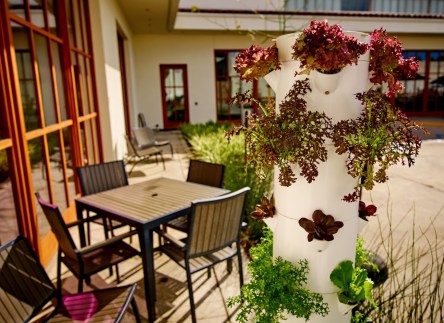Plants do more than beautify your office space. They are a tested, effective, low-cost—and now, low maintenance—way to make your office space a better place to work. The presence of greenery results in increased productivity, improved morale, more amicable interpersonal relations, higher air quality, and decreased stress and anxiety. If those seem like haughty claims, consider the research: The Journal of Experimental Psychology reveals that the presence of greenery in an office space boosts productivity by 15 percent. Plant life is proven to enhance concentration, which not only supports productivity but also fosters creative problem solving and faster learning. When employees are burdened by stress, fuses run short and interpersonal conflicts may escalate. Studies by the Horticulture Research Institute suggests that indoor plants demonstrably reduce stress, thus improve mood and morale in the workplace. In the long term, emotional stress is a contributing factor to the top six leading causes of fatal illness. By reducing stress, businesses can improve employee health and cut costs on absenteeism and health care. It is common knowledge that plants can reduce the presence of carbon dioxide outside. It’s equally as important to note that some plants can combat volatile organic compounds (VOCs) that are commonly found indoors. VOCs are found in paints, adhesives, flooring, furniture, and other office products. Cleaner air contributes to employee health, as well as a reduction in minor setbacks such as headaches and fatigue. Plants have proven their value. So why aren’t more offices packed wall to ceiling with greenery? Terra Basche of Santa Barbara-based Terra Malia Designs recalls common misconceptions about indoor plants. “People think potted indoor plants should be placed in the corner and out of the way. Plants are cared for, but otherwise no one interacts with them. Terra Malia Designs...
Improve Focus + Morale
Recovering from Summer Sales
In multifamily, summers can be intense. Resident turnover is at its highest, career development conferences hit their peak, and you’re caught working with a skeleton crew because part of your staff has cashed-in on its vacation hours. Now that school has started, things may have calmed down, but your head is still spinning. These three tips will help you reconnect with your team and get back on track for the fall. Change of Scenery Nothing says, “fresh start” like new interior designs. Start with paint colors, which can make the greatest psychological impact on your team. If you’re going for a full makeover, Entrepreneur recommends beginning with a neutral tone. Then select an accent color in the blue family (various shades of blues, greens, and violets). Cooler colors are calming and refreshing, which may be just what you need to set a fresh perspective for the new season. Purples may be a good choice if you want to stimulate creativity and imagination. Want to give your crew a burst of energy and optimism? Use a member of the yellow family (yellows, oranges, light greens) as your accent color. Are there colors to avoid? Absolutely. On a large scale, white is perceived as sterile and uninspiring. Red is another color to avoid in large quantities. Some say that red is the signature color of negotiators. More sources suggest that reds can conjure feelings of anxiety and discomfort. The type of paint that you use is also important. Forbes recommends eggshell and satin paints. The slight sheen evokes energy and liveliness. Also, opt for no-VOC brands that promote better indoor air quality and healthier work conditions. Pops of Greenery Studies suggest that the presence of plants in an office can improve productivity, morale, and sales. Research led by Dr. Virginia Lohr of Washington State University concludes that plants in the workplace increase productivity by 12 percent. It gets better. Research led by Dr. Roger S. Ulrich of Texas A&M University revealed that the sight of plants can lower a person’s blood pressure and reduce stress. Ciphr states that the presence of plant life in an office space can reduce anxiety by 37 percent, reduce fatigue by 38 percent, and decrease feelings of anger and hostility by 44 percent. Asking for higher rents? Plants can also boost the perceived value of your property. In retail environments, shoppers are willing to pay about 12 percent more for goods sold in a shopping center with greenery than in a center without plants. You don’t need a green thumb or a high budget for exotic, magical plants. Any plants will do. The important thing is to get plants that you and your team can maintain. (Dying plants might reverse the aforementioned positive benefits.) Succulents and ferns tend to be the easiest plants to care for and can adapt to varying water and light scenarios. Celebrate Your Accomplishments Want to boost your team’s morale instantaneously? Recognize team members for their hard work. Disappointed by their overall performance this summer? Find what was done well and shout it from the rooftops. Odds are, your team already knows its shortcomings and struggles. Reminding people of their faults rarely encourages improvement. Encouragement and positive change come when team members are reminded that they are capable and that their efforts will be acknowledged. Central Michigan University professor Heather Kchodl tells Chron that positive reinforcement is best when issued sincerely, consistently (no picking favorites), and immediately after the desired behavior or action has taken place. Don’t wait until the winter holiday party to tell your team what a great job they did during this...


